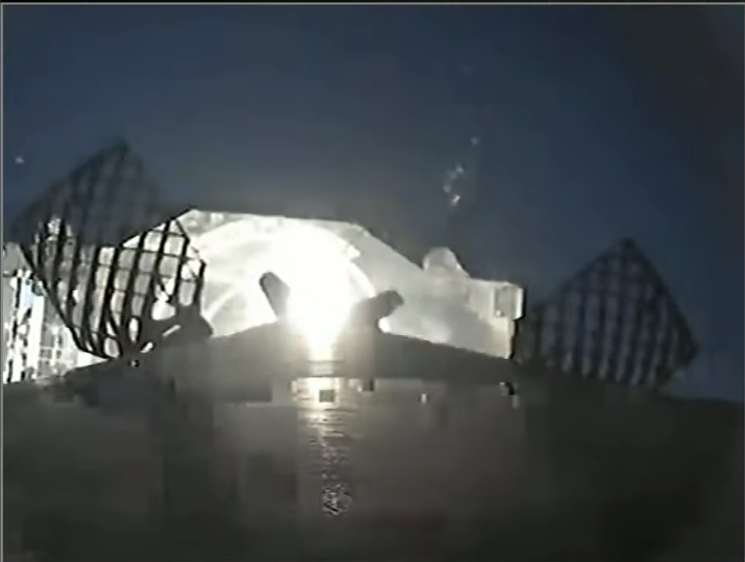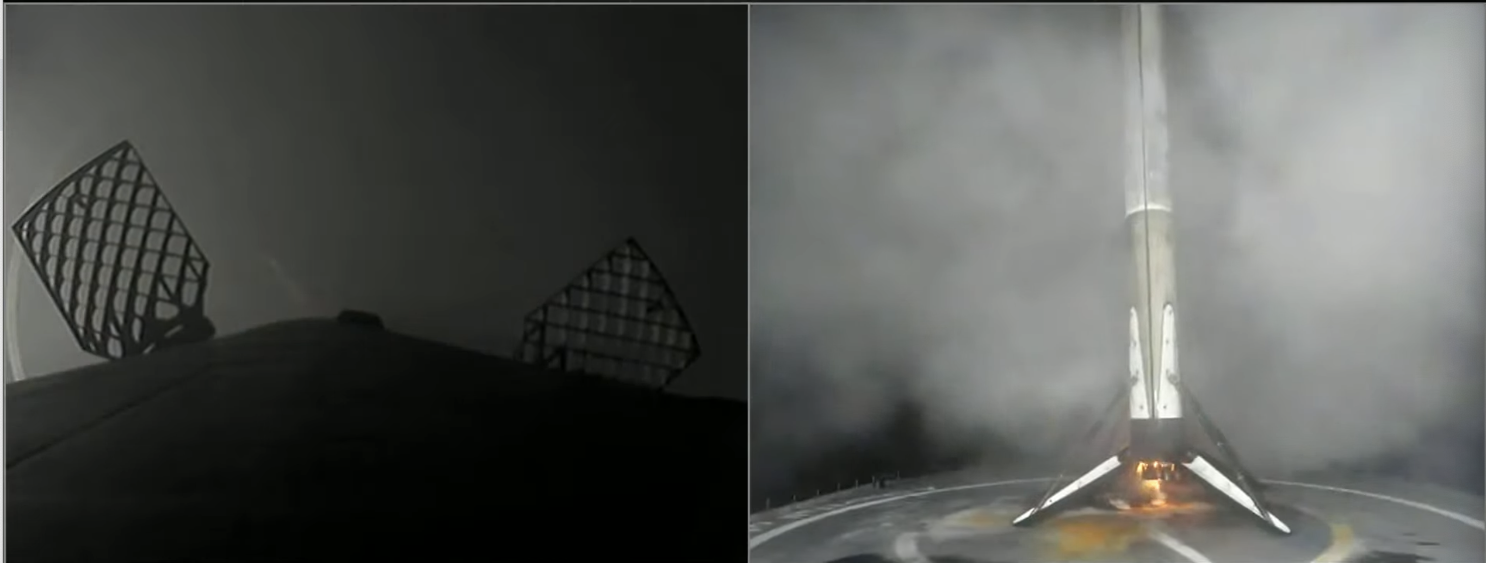
As Artemis I enters formal countdown operations ahead of Monday morning’s historic maiden voyage of the Space Launch System (SLS) rocket, SpaceX looks set to wrap up August on a personal-best-tying six missions, as the Hawthorne, Calif.-headquartered organization heads squarely towards its 40th flight of 2022. A once-time-flown Falcon 9 booster lifted off from storied Space Launch Complex (SLC)-40 at Cape Canaveral Space Force Station, Fla., at 11:41 p.m. EDT Saturday, laden with dozens more Starlink internet communications satellites for emplacement into low-Earth orbit.
Veteran core B1069—which entered the Falcon 9 fleet late last year and flew first in December 2021—was making her second mission in eight months. Having successfully lofted the science-laden CRS-24 Cargo Dragon to the International Space Station (ISS) as part of NASA’s second-round Commercial Resupply Services (CRS2) contract, she touched down a few minutes later on the deck of the Autonomous Spaceport Drone Ship (ASDS), “Just Read the Instructions”.
But the landing apparently did not go without a hitch. According to Derek Wise in commentary and imagery on Space Explored, B1069 touched down “hard” and far from center, right at one of the corners of the drone ship. She knocked down one of the I-beam perimeter rails and caused significant denting to the drone ship’s robotic “Octagrabber” and to her own Merlin 1D+ engines. When the booster returned to Port Canaveral just before Christmas, she exhibited a worrisome sideways tilt.

It seems unsurprising, therefore, that B1069 has been out of service for much of 2022 as she underwent repairs and modifications to fly again. A switch of launch pads was also in order, as operations at historic Pad 39A at the Kennedy Space Center (KSC) are halted as SLS teams established a Blast Danger Area around neighboring Pad 39B for Artemis I hazardous operations and cryogenic tanking over the weekend.
Last week, only a few hours after dropping off the newly-returned B1062 core at Port Canaveral from her most recent mission, the ASDS “A Shortfall of Gravitas” put to sea for her third Falcon 9 “catch” of August. ASOG was destined for a recovery position about 400 miles (650 kilometers) downrange of the launch site, in the Atlantic Ocean.

Outfitted with a glistening suite of nine new Merlin 1D+ engines and a brand-new second stage, B1069 was trundled out to SLC-40 last week and on Thursday underwent a brief Static Fire Test. All four of her landing legs apparently also required replacement after the December anomaly, producing an almost-new booster.
Weather conditions for Saturday night’s opening launch attempt were overshadowed by an unsettled pattern, characterized by the formation of showers and thunderstorms along the East Coast sea breeze. “Showers and storms will decrease into the night,” noted the 45th Weather Squadron at Patrick Space Force Base, “so weather at the end of the launch window will likely be most favorable.”

All told, potential violating factors for Saturday night included the Cumulus Cloud Rule, the Anvil Cloud Rule and the Surface Electric Fields Rule. The 45th predicted a marginal improvement in the outlook from Saturday night to Sunday night’s backup launch attempt, as the Probability of Go (PGo) moved from 40-60 percent to 60-70 percent.
Liftoff was originally targeted for 10:22 p.m. EDT Saturday, but was delayed by more than an hour in response to unacceptable weather. Threading the needle between the storms and showers, B1069 took flight precisely on time at 11:41 p.m. EDT, her nine new engines powering her smoothly uphill for the first 2.5 minutes of ascent.

She separated from the stack to complete a successful touchdown on the ASOG deck. It was the first time that ASOG—the newest member of SpaceX’s ASDS fleet—had supported three Falcon 9 landings in a single calendar month.
With B1069 gone, the Merlin 1D+ Vacuum engine of the second stage ignited for a customary six-minute “burn” to deliver the 54-strong Starlink “stack” to low-Earth orbit about 15 minutes after liftoff. Totaling around 36,000 pounds (16,500 kilograms), the satellites were destined an altitude of 340 miles (550 kilometers), inclined 53.2 degrees to the equator. It was SpaceX’s 24th dedicated Starlink launch of 2022.

Last night’s mission was also the 38th Falcon 9 flight of the year, already greatly surpassing SpaceX’s previous “personal best” of 31 flights at the end of 2021. Another Starlink mission, destined for “Shell 3” at 97.6 degrees inclination, is scheduled to fly from Vandenberg Space Force Base, Calif., as early as Wednesday, 31 August, with an expectation that SpaceX will push through a record-breaking 40 launches early next month.
Starlink’s progress as an internet provider on the world stage has advanced in leaps and bounds in 2022, with availability expanded to Moldova, Estonia and Colombia in August alone. Last night, SpaceX announced that Norway has also signed up for Starlink.

That brings to 18 the number of nations which have adopted Starlink since the start of the year. And since the fall of 2020, regulatory approval for Starlink has been granted for 40 countries and 44 markets across North and South America, Europe and Oceania.
With B1069 safely home and SpaceX’s fifth flight of August complete, attention now turns to historic Pad 39B at KSC for Artemis I. Launch Director Charlie Blackwell-Thompson performed the formal “Call to Stations” of her team in the Rocco A. Petrone Launch Control Center (LCC) at KSC early Saturday morning and countdown operations commenced at 10:23 a.m. EDT, with an expectation that the giant SLS will launch during a two-hour “window”, opening at 8:33 a.m. EDT Monday.

Weather conditions for Artemis I’s opening launch attempt currently stand at 70-percent-favorable, with some risk of violating the Cumulus Cloud Rule, the Surface Electric Fields Rule and Flight Through Precipitation. Despite lower shower and thunderstorm coverage late on Sunday, there may still be scattered showers across the Atlantic waters during Monday’s two-hour window.
Last Thursday, the hatch of the Orion Crew Module (CM) was closed for flight and the Crew Access Arm (CAA)—which connects the spacecraft to the Pad 39B tower at the 274-foot (83.5-meter) level of the 380-foot-tall (115.8-meter) Mobile Launcher (ML)—was retracted from the SLS. The Artemis I Mission Management Team (MMT) met Saturday to discuss the status of this historic flight, which will see a crew-capable spacecraft travel to lunar distance for the first time since Apollo 17, way back in December 1972.
At the MMT meeting, Artemis I Mission Manager Mike Sarafin of NASA Headquarters in Washington, D.C., noted a “heightened sense of anticipation” but remained “mindful that this is a test flight”. He pointed to a 1:125 risk of Loss of Vehicle (LOV), dictated by a raft of probabilistic risk factors spearheaded by the SLS guidance and control hardware, Orion’s heat shield, parachutes and other critical systems.
Artemis I Launch Director Charlie Blackwell-Thompson reported on an on-time Call to Stations and declared her anticipation that loading the SLS with over 733,000 gallons (3.3 million liters) of liquid oxygen and hydrogen would occur after midnight Sunday. She explained that the tanking protocol would begin with the Core Stage—first liquid oxygen, followed by liquid hydrogen—before teams press onto fueling the Interim Cryogenic Propulsion Stage (ICPS) with its own load of cryogens.

To guard against delays, she noted that the first of two built-in “holds” in the countdown—the one just prior to cryogenic tanking—has been extended in duration from 90 minutes to 150 minutes. The Core Stage and the ICPS are expected to be fully loaded and in “replenish” mode by 6 a.m. EDT Monday.
A final built-in hold at T-10 minutes, timed to last for 30 minutes, will allow Ms. Blackwell-Thompson and her team to complete their final checks and declare their readiness to support the launch. With a “Clear Constraints Board”, she told media on Saturday, the countdown will pick up at T-10 minutes and tick towards an opening of the launch window at 8:33 a.m. EDT.

She explained that the teams are presently working no technical issues of note, although Mother Nature and the vehicle can always throw a final spanner into the works and best-laid plans, as Robert Burns once wrote, can sometimes be thrown adrift. On Saturday afternoon, rain and thunderstorms at KSC produced three lightning strikes on Pad 39B’s 600-foot-tall (200-meter) lightning protection system towers.
One strike was recorded on Tower 1 and two strikes at Tower 2. “Initial indications are that the strikes were of low magnitude,” NASA reported. “A weather team has begun an assessment that includes collecting voltage and current data, as well as imaging. The data will be shared with a team of experts on electromagnetic environment efforts, who will determine if any constraints on vehicle or ground systems were violated.”






5 Comments
5 Pings & Trackbacks
Pingback:SpaceX Launches Fourth Falcon 9 of October, Fourth Geostationary Mission of Year - AmericaSpace
Pingback:SpaceX Resumes Falcon 9 Launches, Heads into Busy Year-End - AmericaSpace
Pingback:SpaceX Resumes Falcon 9 Launches, Heads into Busy Year-End - Space News
Pingback:Launch-Heavy February Dawns With 200th Falcon 9 Mission Success - AmericaSpace
Pingback:Launch-Heavy February Dawns With 200th Falcon 9 Mission Success - Space News